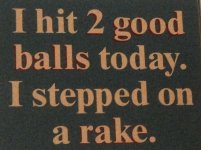Your right.It is harder than you think. And little benifit compared to the cost of the flexible tag PCB + extra manufacturing steps to center it.
You are using an out of date browser. It may not display this or other websites correctly.
You should upgrade or use an alternative browser.
You should upgrade or use an alternative browser.
Aramith Balls
- Thread starter RD123
- Start date
ASKA billiards, apparently. Looks like they have a retail location in Canada. Maybe they just screwed up the description.Who is the seller? Imperial USA is an authorized Aramith reseller.
23DenaliBDE
Well-known member
I specifically remember Brad Pitt thinking that same thing.........WHATS IN THE BOX?!?!?The first commandant of pool ball collecting is:
"What is in the box is probably not what came in the box..."
The polishing stage makes it difficult to add features at a fixed radius from the center, since the center of mass drifts unpredictably. Hard to place right below the vitrification layer.How about embedded microprinting?
A nano scale print is a strong authentication technique.
Or Maya RudolphI specifically remember Brad Pitt thinking that same thing.........WHATS IN THE BOX?!?!?
The polishing stage makes it difficult to add features at a fixed radius from the center, since the center of mass drifts unpredictably. Hard to place right below the vitrification layer.
How about a chemical binary compound test ? The lower quality balls should have a below threshold standard, which compound in the polish dilutes it the most?
23DenaliBDE
Well-known member
Or Maya Rudolph
My gametop golf balls…
…I told them if my ball ended up in the rough, I wanted to know it was me who put it there.
Attachments
Any new box of Aramith balls from a legitimate seller should come to you shrink wrapped. However, I’m sure there are ways to re-apply shrink wrap to a box of balls.The first commandant of pool ball collecting is:
"What is in the box is probably not what came in the box..."
How about a chemical binary compound test ? The lower quality balls should have a below threshold standard, which compound in the polish dilutes it the most?
Attachments
That pretty much applies to anything sold on-line. Amazon is just the middleman/shipper. Unless you buy direct from manuf., which you can't with Aramith, you run the risk of knock-off. I don't think these balls are fakes. Simple misprint imo.Amazon = the junk yard. They have pretty much zero quality control when it comes to brand name items. Don’t buy from there unless it’s a commodity or something you don’t care is a knockoff.
The RFID assembly could be made the same density as the ball (silicon + lighter plastic) but then few would have the interest/equipment to test for authenticity. Aramith has partly solved the problem by having logo-branded shrink-wrap so an empty box can't be filled with counterfeit so easily.It is harder than you think. And little benifit compared to the cost of the flexible tag PCB + extra manufacturing steps to center it.
The room where I played got a set of Aramiths to replace lost/chipped balls. Nice box, no shrink-wrap, bad balls.
They could mark the balls the same way diamonds can be marked -- the gem not the table.
The standard for marking diamonds is with a laser inscription where it will not normally show up. Probably not a good idea for pool balls.
An alternative is to use an ion beam. You shoot atoms of whatever material you want into the thing to mark/identify, writing the text/numbers with a narrow beam. Those few atoms don't affect the material. If the atoms you used fluoresce, you just shine the right UV light on it and the text lights up. In the case of diamond, you can write on a visible facet. Probably expensive.
I think the main problem with most schemes is that Joe Consumer won't be able to check for himself. The logoed shrink wrap seems like the right solution: obvious to the customer if they know to look for it, cost about $0.01 per box, and relatively hard to duplicate.
The standard for marking diamonds is with a laser inscription where it will not normally show up. Probably not a good idea for pool balls.
An alternative is to use an ion beam. You shoot atoms of whatever material you want into the thing to mark/identify, writing the text/numbers with a narrow beam. Those few atoms don't affect the material. If the atoms you used fluoresce, you just shine the right UV light on it and the text lights up. In the case of diamond, you can write on a visible facet. Probably expensive.
I think the main problem with most schemes is that Joe Consumer won't be able to check for himself. The logoed shrink wrap seems like the right solution: obvious to the customer if they know to look for it, cost about $0.01 per box, and relatively hard to duplicate.
They could mark the balls the same way diamonds can be marked -- the gem not the table.
The standard for marking diamonds is with a laser inscription where it will not normally show up. Probably not a good idea for pool balls.
An alternative is to use an ion beam. You shoot atoms of whatever material you want into the thing to mark/identify, writing the text/numbers with a narrow beam. Those few atoms don't affect the material. If the atoms you used fluoresce, you just shine the right UV light on it and the text lights up. In the case of diamond, you can write on a visible facet. Probably expensive.
I think the main problem with most schemes is that Joe Consumer won't be able to check for himself. The logoed shrink wrap seems like the right solution: obvious to the customer if they know to look for it, cost about $0.01 per box, and relatively hard to duplicate.
Educating the consumer before Joe meets the counterfeiting team is a popular problem.
I went only to reputable dealers, it was Blatt Billiards when they had a public show room.
The only time I've ever considered a purchase of new equipment is when a tournament ends.
Most online users know counterfeit and lower quality products are sold through online sites.
I thought teams exist to study the people that counterfeit an industry.
What kind of damage does counterfeit pool products do? What are the stories if you can share?
You also have to use expensive software to design an RFID antenna that is tuned to the ball, since the dielectric constant shifts the resonant frequency downwards. You can’t just use an off the shelf solution. This immediately requires $10k or more in FCC certification. This is exactly what I had to do with my project, only for 2.4 GHz instead of RFID frequencies.The RFID assembly could be made the same density as the ball (silicon + lighter plastic) but then few would have the interest/equipment to test for authenticity. Aramith has partly solved the problem by having logo-branded shrink-wrap so an empty box can't be filled with counterfeit so easily.
The room where I played got a set of Aramiths to replace lost/chipped balls. Nice box, no shrink-wrap, bad balls.
The density of FR4 is about 1.1 and phenolic is 1.72 g/mL. You can use a polyamide flex circuit that is thin and negligible to get around this problem.
RFID is possible but expensive to get working correctly.
I quit using moori tips because I was tired of buying high priced knockoffs that wore out quickly. It's a shame too, moori has a real nice product.That pretty much applies to anything sold on-line. Amazon is just the middleman/shipper. Unless you buy direct from manuf., which you can't with Aramith, you run the risk of knock-off. I don't think these balls are fakes. Simple misprint imo.

